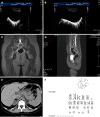Turner syndrome with positive SRY gene and non-classical congenital adrenal hyperplasia: A case report
- PMID: 33869601
- PMCID: PMC8026834
- DOI: 10.12998/wjcc.v9.i10.2259
Turner syndrome with positive SRY gene and non-classical congenital adrenal hyperplasia: A case report
Abstract
Background: Co-morbidity of SRY gene turner syndrome (TS) with positive SRY gene and non-classical congenital adrenal hyperplasia (NCAH) is extremely rare and has never been reported to date.
Case summary: In this article, we present a 14-year-old girl who was referred to our hospital with short stature (weight of 43 kg and height of 143 cm, < -2 SD) with no secondary sexual characteristics (labia minora dysplasia). Laboratory tests indicated hypergonadotropic hypogonadism with significantly increased androstenedione and 17-hydroxyprogesterone (17-OHP) levels. This was accompanied by the thickening of the extremity of the left adrenal medial limb. The patient's karyotype was 45,X/46,X, +mar, and cytogenetic analysis using multiplex ligation-dependent probe amplification and high-throughput sequencing indicated that the SRY gene was positive with compound heterozygous mutations in CYP21A2 as the causative gene for congenital adrenal hyperplasia. The sites of the suspected candidate mutations were amplified and verified using Sanger sequencing. The patient was finally diagnosed as having SRY positive TS with NCAH. The patient and her family initially refused medical treatment. At her most recent follow-up visit (age = 15 years old), the patient presented facial hair, height increase to 148 cm, and weight of 52 kg, while androstenedione and 17-OHP levels remained high. The patient was finally willing to take small doses of hydrocortisone (10 mg/d).
Conclusion: In conclusion, upon evaluation of the patient mentioned in the report, we feel that 17-OHP measurement and cytogenetic analysis are necessary for TS patients even in the absence of significant virilization signs. This will play a significant role in guiding diagnosis and treatment.
Keywords: Case report; Congenital adrenal hyperplasia; Diagnosis; Endocrinology and metabolism; SRY gene; Tumor; Turner syndrome.
©The Author(s) 2021. Published by Baishideng Publishing Group Inc. All rights reserved.
Conflict of interest statement
Conflict-of-interest statement: The authors declare that they have no conflict of interest to report.
Figures


Similar articles
-
Rare Coexistence of Congenital Adrenal Hyperplasia due to 21-Hydroxylase Deficiency and Turner Syndrome: A Case Report and Brief Literature Review.J Clin Res Pediatr Endocrinol. 2023 Feb 27;15(1):86-89. doi: 10.4274/jcrpe.galenos.2021.2021.0174. Epub 2021 Aug 6. J Clin Res Pediatr Endocrinol. 2023. PMID: 34355878 Free PMC article.
-
Nonclassic congenital adrenal hyperplasia misdiagnosed as Turner syndrome.J Hum Reprod Sci. 2015 Oct-Dec;8(4):239-41. doi: 10.4103/0974-1208.170416. J Hum Reprod Sci. 2015. PMID: 26751945 Free PMC article.
-
A rare combination: congenital adrenal hyperplasia due to 21 hydroxylase deficiency and Turner syndrome.J Clin Res Pediatr Endocrinol. 2012 Dec;4(4):213-5. doi: 10.4274/jcrpe.767. J Clin Res Pediatr Endocrinol. 2012. PMID: 23261864 Free PMC article.
-
[Rapidly progressive puberty in a patient with mosaic Turner syndrome: a case report and literature review].Zhonghua Er Ke Za Zhi. 2017 Feb 2;55(2):125-130. doi: 10.3760/cma.j.issn.0578-1310.2017.02.014. Zhonghua Er Ke Za Zhi. 2017. PMID: 28173651 Review. Chinese.
-
46, XX SRY-positive male syndrome presenting with primary hypogonadism in the setting of scleroderma.Endocr Pract. 2011 Jan-Feb;17(1):95-8. doi: 10.4158/EP10184.CR. Endocr Pract. 2011. PMID: 20841307 Review.
References
-
- Kurnaz E, Çetinkaya S, Savaş-Erdeve Ş, Aycan Z. Detection of the SRY gene in patients with Turner Syndrome. J Gynecol Obstet Hum Reprod. 2019;48:265–267. - PubMed
-
- Ibrahim MN, Laghari TM, Hanif MI, Khoso ZA, Riaz M, Raza J. Comparison of Classical and Non-Classical Turner Syndrome at NICH Karachi. J Coll Physicians Surg Pak. 2018;28:840–843. - PubMed
-
- Kavoussi SK, Christman GM, Smith YR. Healthcare for adolescents with Turner syndrome. J Pediatr Adolesc Gynecol. 2006;19:257–265. - PubMed
-
- Bispo AV, Dos Santos LO, Burégio-Frota P, Galdino MB, Duarte AR, Leal GF, Araújo J, Gomes B, Soares-Ventura EM, Muniz MT, Santos N. Effect of chromosome constitution variations on the expression of Turner phenotype. Genet Mol Res. 2013;12:4243–4250. - PubMed
Publication types
LinkOut - more resources
Full Text Sources
Other Literature Sources

